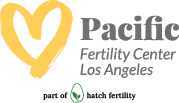IVF risks and complications
Learn about the risks and complications associated with in vitro fertilization before starting your cycle.
Our doctors at PFCLA have performed more than 10,000 IVF procedures, and you can feel assured knowing you're in the hands of a world-renowned team. However, any medical procedure brings its own considerations, so it's important to understand the potential risks that can occur during IVF. Make sure you discuss any risks with your doctor, as every case is unique.
Complications associated with IVF
At PFCLA, we want to provide you and your partner with full transparency into the complications associated with IVF. The following includes some of the complications associated with IVF.
Ovarian hyperstimulation syndrome (OHSS)
OHSS is a condition generated by the production of multiple eggs with injectable fertility drugs such as HCG. Some symptoms include bloating, abdominal pain, nausea and weight gain. There are varying levels of OHSS, with mild symptoms resolving in a matter of two to three days and more severe symptoms, which can require an abdominal drainage of accumulated fluid (ascites) and occasional hospitalization. Symptoms of OHSS typically last one week.
Note: The incidence of mild OHSS occurs in about 10% of cases and is severe in less than 1%.
Bleeding during your egg retrieval (ER)
Most bleeding is controlled with simple pressure and resolved without further need for intervention. This bleeding is often caused by a blood vessel puncture (a needle hitting the vaginal wall during egg collection). Similarly to drawing blood, if pressure is not applied to the wound, you would show signs of bleeding for a few minutes.
Note: It is rare for internal bleeding to develop from the ovaries as they are punctured. The risk is always there, but severe bleeding only happens once in every 3,000 retrievals.
In a vast majority of cases that occur in our clinic, your nurses will send you home after a few hours of observation to ensure the bleeding has stopped.
Infections
Infections can occur where there is a risk of introducing pathogens or bacteria. This can happen during the procedure where the needle is inserted. There are several ways to combat this. One example is to provide you or your partner with prophylactic antibiotics during the egg retrieval to prevent such infections.
Note: Severe pelvic infection only happens once in every 6,000 retrievals.
Ovarian torsion
This is a rare but serious side effect. Ovarian torsion happens when the ovary or fallopian tube twists around its supportive tissue, cutting off blood supply to the ovary. This condition occurs when there is ovarian instability. Masses on the ovary, for example, make the organ disproportionate and vulnerable to torsion.
If this were to occur, immediate surgical intervention is required to correct it. If treated promptly and appropriately, there is a good chance of full recovery. The symptoms of ovarian torsion occur very suddenly, with an intense feeling of severe pain, nausea, or vomiting.
Note: Ovarian torsion only happens once in every 6,000 retrievals.
Ectopic pregnancy
An ectopic pregnancy happens when the embryo grows outside the uterus (usually in the fallopian tubes). This is caused by a misshapen or inflamed fallopian tube. If you experience this risk immediate medical attention is required to avoid life threatening symptoms.
Note: Ectopic pregnancy occurs twice as often with IVF compared to natural conception, with a 5% incident rate.
A little expertise can put your mind at ease
Gain an in depth understanding towards three main risks and
complications associated with IVF, and the options available to overcome them.
Ectopic pregnancy
Develop a better understanding of the symptoms associated with ectopic pregnancy and the available options you or your partner can take to treat it.
Ovarian hyperstimulation syndrome (OHSS)
Learn about the associated symptoms of OHSS, its causes and the treatments available for your or your partner to overcome this risk should it arise during the fertility treatments.
Westwood Location
10880 Wilshire Blvd, Ste 300
Los Angeles, CA 90024
Call Us: (310) 564-9194
Glendale Location
1818 Verdugo Blvd, Ste 402
Glendale, CA 91208
Call Us: (310) 564-9194




